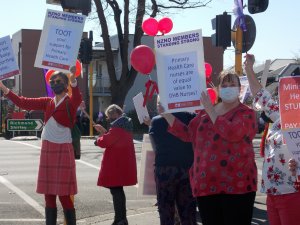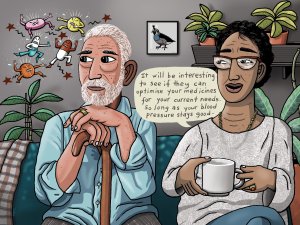For older people and frail people, the long-term benefit of medicines reduces and the potential for harm from adverse effects increases. When the benefit–risk balance changes in this way, medicine review and optimisation are important to simplify the therapeutic regimen, reduce inappropriate medicines and minimise risks. In this article, pharmacist prescriber Linda Bryant uses two case studies to illustrate important considerations during medicine reviews
Nursing pay limbo shows health systems evolve, not follow design
Nursing pay limbo shows health systems evolve, not follow design

The plight of primary care nurses highlights how health policy often results from unintended shifts and not grand plans, writes Tim Tenbensel
If governments and agencies spend so much time and energy formulating plans, why is so much that happens in health unexpected, unintended or unwanted?
“Every system is perfectly designed to get the results that it does.” I regularly heard this aphorism by American management consultant W. Edwards Deming, quoted by health sector leaders and gurus of change in the 2010s.
The Deming quote is a call to get problem-solvers enthused about designing a better system. But is it really helpful to think of health systems and health policy as the product of design?
On hearing the news about the Government’s changes to pay equity legislation in early May, my first thoughts, like many readers of this publication, went to nurses in primary healthcare.
This is just the latest in a series of unfortunate events for primary care nurses, including the slow crisis in primary healthcare funding and the snail’s pace of the review process, the backwash of the 2023 pay rise for Health New Zealand Te Whatu Ora nurses, and the stalemate in negotiations between the Government and GenPro.
This example of primary care nurses’ pay emphatically illustrates the limitations of thinking about policy as the product of design.
No one intended this state of affairs. Sure, ministers and organisations have taken specific decisions or kicked cans down the road to whom you can attribute some responsibility. But no government or any other organisation or profession designed it.
In government agencies, generally, we see a plethora of plans, strategies, framework documents issuing forth. When those in the sector see deficiencies and neglect of patient groups, health conditions, for example, a typical response is to call for an action plan that can be used to guide further decisions about funding and service delivery.
Very few of these plans and strategies contain detailed designs. Instead, they typically set out principles by which those in other parts of the system should draw up more specific designs.
If governments and health sector agencies spend so much time and energy formulating and announcing plans, why is so much that happens in health unexpected, unintended or unwanted by anyone?
Design is important for working out the details of new initiatives. For example, there is a need for some element of careful design when fleshing out the details of, say, a $285 million performance-based boost for primary care.
The original capitation formula for primary care practices was clearly the product of some design, and some international experts regarded this as good-quality design to boot.
But Deming’s aphorism really should not be applied to something as large and complex as a health system. An alternative mindset is one that accepts that the world of health systems is not the product of intentional design.
Health policy researchers have increasingly made use of the metaphor of evolution. Examples such as the policy vacuum regarding primary care nursing pay make more sense if we see them as the product of “accidental logics”.
Evolution is a powerful set of concepts that has applied to technology, law, market economies, as well as biology. At its core, evolution describes a dynamic relationship between something (a species, a practice, an organisation) and its environment.
But the social sciences evolution has some heavy historical baggage. The social Darwinists of the late 19th century took “survival of the fittest” to mean something very different to Charles Darwin and a justification for eugenics.
As a way of understanding change, evolution was synonymous with slow, incremental, imperceptible rates of change. However, biologists such as Stephen Jay Gould showed how evolution could occur rapidly, and this insight was soon adopted and embraced by many policy researchers seeking to understand both slow and fast change.
The idea of “co-evolution”, where species and environments evolve together, and pairs of species evolve in relation to each other, is useful for understanding the dance between health funders and providers.
In the dance between the Government and the primary care sector, neither side has been willing to take overall responsibility for determining the pay and working conditions of primary care nurses because of the long-term financial consequences.
The primary healthcare capitation formula was designed, and by its nature, it is static – it has not evolved. However, the sector continued to evolve so that nurses have become a much more significant component of the workforce and services.
This has been the product of demographic change, increased professionalisation of nursing, the increased prevalence of chronic conditions, and changes in the size of practices.
Darwin upended 19th-century Christian cosmology by suggesting that biological evolution did not require anyone or anything to intend things into existence.
Of course, health policy is full of people and organisations doing things with intent, some with more effect than others; some more able to exert some control over what happens.
But that can still mean that outcomes, such as the limbo that primary care nurses find themselves in, are not what anyone or any group intended.
While this is a problem that should be addressed urgently, the answer does not require anyone to play God. Instead, it requires all players to understand their place and role in our health system ecology and how each needs to adapt to the changing environment.
When players play by rules devised over 20 years ago, the game itself needs to change.
Tim Tenbensel is professor of health policy at the University of Auckland
TELL US WHAT YOU THINK
Send a Letter to the Editor to editor@nzdoctor.co.nz
We're publishing this article as a FREE READ so it is FREE to read and EASY to share more widely. Please support us and our journalism – subscribe here
One of the benefits of subscribing is you will also be able to share your thoughts about what you read with others in our Comment Stream. You can also take notes on what you read with Capture



![[Image: National Cancer Institute on Unsplash]](/sites/default/files/styles/cropped_image_4_3/public/2022-11/national-cancer-institute-NFvdKIhxYlU-unsplash.jpg?itok=AgI-pPBO)




